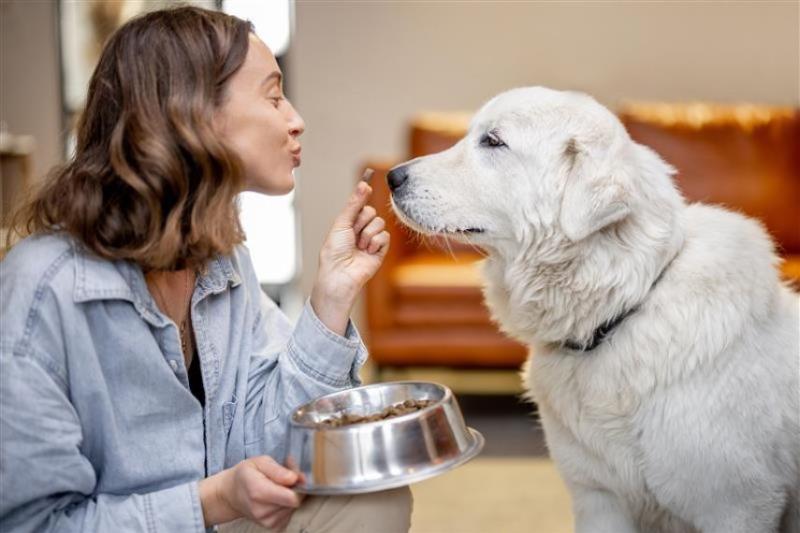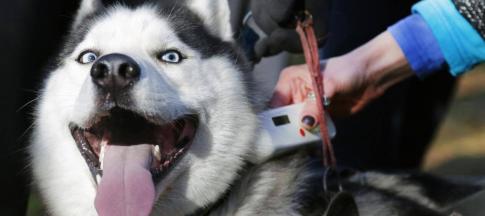
Keeping your pet healthy and happy is your top priority. A big part of this is making sure they’re getting the right nutrition.
In this dog feeding guide we cover everything you need to know, from what human foods they can and can’t eat to how many calories they should be eating daily.
What can I feed my dog?
While a lot of human food is really not suitable to share with your dog, there are actually some which can make great snacks for your furry friend.
- Carrots – these are a good source of vitamin A and are also good for their dental hygiene as crunching them helps remove plaque
- Apples – a good source of fibre to help maintain healthy digestion but make sure to avoid the pips
- White rice – this is often recommended by vets for dogs who have an upset stomach as it’s easy to digest and helps to bind stools
- Plain, boiled chicken breast – along with white rice, vets often recommend plain chicken for dogs if they have an upset tummy
- Blueberries – these are a good source of fibre and antioxidants
- Peanut butter – this must be unsalted with no added sugar or sweeteners (the artificial sweetener Xylitol is particularly dangerous as it is highly toxic to dogs and can cause liver failure)
- Bananas – a tasty treat but high in sugar so should only be given occasionally
- Cucumber – a low-calorie, cool and crunchy snack that many dogs love
It’s important to remember that while some fruits and veg are safe for a dog, they should only be fed as an occasional treat, alongside a balanced diet.
What foods can my dog not eat?
There are a few foods that you shouldn’t share with your dog or leave them with easy access to.
- Grapes and raisins – these can cause kidney failure, even in small amounts
- Xylitol (artificial sweetener) – this sounds scary but is in a lot of sweets, chewing gum and cakes so it’s super important you check
- Avocados – they contain a toxin called persin, which can cause vomiting and diarrhoea in dogs
- Chocolate – this contains something called theobromine, which is highly toxic to dogs
- Macadamia nuts – these are poisonous to dogs and can cause vomiting and muscle weakness
- Garlic, onion, leeks, chives – these are important to remember as it’s very common to cook with garlic and onion especially, but they contain a toxin which can lead to anaemia and trouble breathing
- Caffeine – while dogs can technically have caffeine in very small amounts, large amounts can be extremely dangerous and can cause vomiting, tremors and more
- Alcohol – alcohol isn’t just present in your drinks, but also in lots of cleaning products, and can be fatal to dogs
- Corn on the cob – while corn itself isn’t poisonous, the cob can be really dangerous if they ingest it
- Cooked bones – these can splinter, cause constipation and worst case scenario, puncture your dog’s gut
How much should I feed my dog?
How much you need to feed your dog depends on their size, age, breed, and any health conditions.
For instance, higher-energy or larger dogs will need more food than dogs who are smaller or have less active lifestyles.
Whatever food you buy for your pet should have some rough guidelines included with them, as well as an indication of how many calories they contain.
If you’re not sure, it’s best to speak to your vet who can give you proper guidance based on your pet’s specific needs.
How many calories should my dog eat?
It’s not one-size-fits-all and as always, it depends on a range of things.
Puppies do need more calories than adult dogs to help them grow whilst spayed or neutered dogs actually need less calories.
On the other hand, pregnant dogs may need more calories towards the end of their pregnancy to sustain them.
If you’re not sure, it’s always best to chat with your vet to get their expert opinion.
Wet or dry food?
There are pros and cons to both, and it will come down to your budget, your dog’s eating habits, their dental health, age, and any existing health conditions.
Also, your vet may recommend either dry or wet food based on your dog’s specific needs.
Dry food
- Dry food is often cheaper than wet food.
- It’s easier to portion out dry food and allow it to sit out for a longer if your dog is more of a grazer when it comes to eating.
- It’s often better for their teeth, as they have to chew.
Wet food
- Wet food is easier to chew if your dog is old or has dental issues.
- It’s better at hydrating your dog if they struggle with water intake or have a condition like kidney disease.
- For sick or older dogs who have less of an appetite, it tends to be more flavourful and is more likely to actually get them to eat.
How many treats can I give my dog?
We understand it’s really tempting to shower our dogs in treats. But it’s important they have a healthy and balanced diet and don’t become overweight.
Roughly, the number of treats you give your pup per day shouldn’t be more than 10% of their total daily calories.
If you’re giving them a lot of treats, consider reducing the size of their meals.
Remember those high-value treats are usually really high in calories so try to give them only one or two a day.
If you can, get them excited about healthy snacks as this means you’ll be able to give them more.
What food is recommended for puppies?
Feeding adult dogs is different to feeding puppies.
Puppies need more calories because they need specific nutrients to grow, and you’ll need to make sure you choose a good quality puppy-specific food.
If you’re not sure which one to pick, chat to your vet. Puppies need to eat more frequently than adult dogs too, so when you bring them home, you’ll need to feed them four meals a day.
At around four months you can reduce this to three meals, and at around six months reduce it to two.
I’ve spent 20 years writing about pets and exploring the wonderful relationships they have with their owners. I started as a staff writer on Dogs Today magazine, working my way up to become deputy editor in 2008. In 2010, I left the office to pursue a freelance career, relocated to north Norfolk and started a family.
Over the years I’ve contributed thoughtful human-interest features, celebrity interviews and investigative news stories to publications including The Sunday Times, Dogs Today, Dogs Monthly and Your Cat. I’ve also ghost-written veterinary books and press releases for the pet industry.
When I’m not writing, I enjoy long walks in the Norfolk countryside with my rescue lurcher Popsie. These are always followed by tea and cake.




